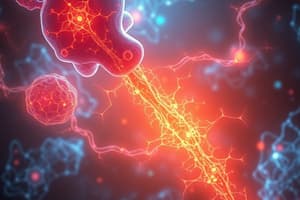Podcast
Questions and Answers
Which of the following best describes an endocrine gland?
Which of the following best describes an endocrine gland?
- A gland that has no significant role in metabolism
- A gland that connects with the nervous system directly
- A gland that secretes substances outside the body
- A cluster of cells that produces hormones within the body (correct)
Neuroendocrine hormones are synthesized by muscular tissue.
Neuroendocrine hormones are synthesized by muscular tissue.
False (B)
What is the primary function of hormones within the endocrine system?
What is the primary function of hormones within the endocrine system?
Regulate bodily functions and maintain homeostasis.
Hormones are subjected to tight regulation by feedback from target __________.
Hormones are subjected to tight regulation by feedback from target __________.
Match the following types of hormones with their characteristics:
Match the following types of hormones with their characteristics:
What is the primary role of negative feedback in hormone regulation?
What is the primary role of negative feedback in hormone regulation?
Peptide hormones are formed directly from cholesterol.
Peptide hormones are formed directly from cholesterol.
Name one major hormone produced by the pituitary gland.
Name one major hormone produced by the pituitary gland.
The ________ is the gland responsible for synthesizing estrogen.
The ________ is the gland responsible for synthesizing estrogen.
Which of the following hormones is primarily involved in the regulation of blood pressure?
Which of the following hormones is primarily involved in the regulation of blood pressure?
Which modification involves the attachment of carbohydrate chains to proteins?
Which modification involves the attachment of carbohydrate chains to proteins?
Arachidonic acid is a derivative of amino acids.
Arachidonic acid is a derivative of amino acids.
What hormone is secreted by the pineal gland during dark phases?
What hormone is secreted by the pineal gland during dark phases?
The pancreas secretes _________ to lower blood glucose levels.
The pancreas secretes _________ to lower blood glucose levels.
Which of the following hormones promotes the production of red blood cells in the bone marrow?
Which of the following hormones promotes the production of red blood cells in the bone marrow?
Match the gland with its primary hormone:
Match the gland with its primary hormone:
Eicosanoids primarily exert endocrine effects throughout the body.
Eicosanoids primarily exert endocrine effects throughout the body.
Name a hormone released by the gastrointestinal tract that stimulates the pancreas.
Name a hormone released by the gastrointestinal tract that stimulates the pancreas.
Dopamine, norepinephrine, and epinephrine are all derived from ________.
Dopamine, norepinephrine, and epinephrine are all derived from ________.
What effect does cholecystokinin have?
What effect does cholecystokinin have?
Flashcards are hidden until you start studying
Study Notes
Endocrine System
- Endocrine glands produce and release hormones within the body
- Hormones act at a distance from the release site
- Paracrine hormones act on nearby cells
- Autocrine hormones act on the same cell that secreted them
- Neuroendocrine hormones are synthesized by nervous tissue and carried in the blood
Hormones
- Regulatory chemicals synthesized by endocrine glands and secreted into the bloodstream
- Act on target cells to alter metabolism
- Involved in maintaining homeostasis
- Subject to tight regulation by feedback mechanisms
Negative Feedback Control
- Regulates hormone release by acting as a loop
- Example: Estrogen secretion from the ovary leads to LH release from the pituitary gland
- LH causes ovulation and removal of follicle, leading to decrease in estrogen and reduction in LH
- Example: LH released from the pituitary gland stimulates the ovary to produce estrogen
Hormone Classification
- Steroid hormones are synthesized from cholesterol by multiple enzymes
- Steroid hormones are lipid-soluble and can diffuse through cell membranes
- Peptide, protein, and glycoprotein hormones are chains of amino acids
- The sequence of amino acids determines the hormone's structure and function
- Synthesized via transcription and translation
- Modified after translation by adding carbohydrates (glycosylation) or phosphate groups (phosphorylation)
- Packaged in the endoplasmic reticulum and Golgi apparatus
- Released by exocytosis
- Amino acid-derivative hormones are derived from tyrosine or tryptophan
- Examples include thyroid hormones (T3 and T4) and catecholamines (dopamine, norepinephrine, epinephrine)
- Fatty acid-derivative hormones (eicosanoids) are produced from cell membrane phospholipids, particularly arachidonic acid
- Eicosanoids have mainly autocrine and paracrine effects
Major Endocrine Glands
- Pineal Gland: located on the roof of the third ventricle, secretes melatonin which is influenced by the hypothalamus and plays a role in sleep patterns and season recognition
- Gastric Tract: stomach wall releases gastrin to stimulate acid secretion; small intestine secretes secretin to stimulate the pancreas, cholecystokinin to stimulate the pancreas and gallbladder, and gastric inhibitory peptide to inhibit stomach activity.
- Kidneys: secrete renin which increases aldosterone secretion by the adrenal cortex; produce erythropoietin to increase production of red blood cells in bone marrow.
- Adipose Tissue: releases leptin and other adipokins to communicate energy storage status to the hypothalamus, regulating appetite.
Table: Endocrine Gland, Hormone, and Effects
- Pancreas: Insulin promotes glucose uptake by many organs; glucagon stimulates glycogen formation in the liver
- Liver: Somatomedins (IGFs) stimulate growth in multiple organ systems
Studying That Suits You
Use AI to generate personalized quizzes and flashcards to suit your learning preferences.




